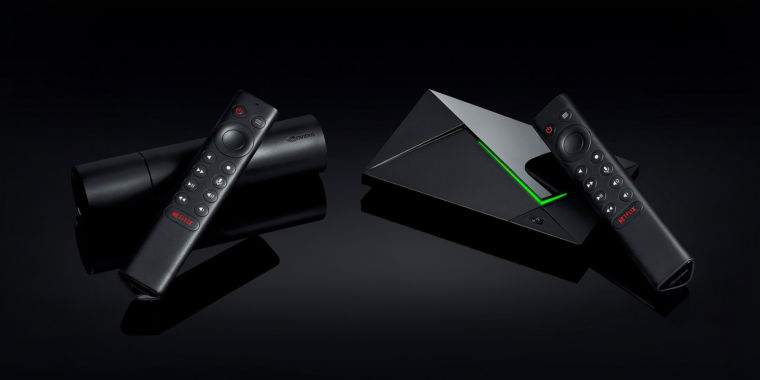
-
The Shield TV and Shield TV Pro.
-
The $149 Shield TV has a crazy cylindrical design.
-
The ports are on the top and bottom of the cylinder.
-
Nvidia wants you to use the Shield TV like an in-line computer: just plug everything in and toss it behind your entertainment center.
-
The triangle remote.
-
The Shield TV Pro is the same design as the 2017 model.
-
There are still lots of ports.
Nvidia’s Shield TV line has been providing Android TV’s best set-top boxes since the first model debuted in 2015. The Shield TVs have been basically the only high-end Android TV devices on the market for their entire runs, standing as a stark contrast to the no-name junk-boxes that typically dominate the Android TV product selection. After the first-generation launch in 2015 and a second-generation version in 2017, Nvidia is launching two new third-generation Nvidia Shield TVs today, right on schedule, in 2019. The new Shields are faster and have a new remote, and one of them comes in a new form factor!
There are two devices to look at: the $149.99 Nvidia Shield TV and $199.99 Nvidia Shield TV Pro. Like 2017’s Shields, Nvidia doesn’t append any version numbers to the Shields, so these will be the called “2019 Editions.” The $200 Pro device is same set-top-box design that Nvidia has been using for years, with an upgraded Nvidia Tegra X1+ SoC, 3GB of RAM, and 16GB of storage. The back, as usual, is loaded with ports: HDMI 2.0, two USB-A 3.0 ports, and for serious streaming power, wired Gigabit ethernet. 16GB is not a ton of storage, but you can plug any mass-storage device you want into the USB 3.0 ports, be it a flash USB stick or full-on hard drive, or you can connect to network attached storage. The 2017 Pro had a $300 SKU with 500GB of onboard storage, but it was discontinued last year, and a “high storage” SKU is not available on the 2019 version.
The cheaper Nvidia Shield TV has this crazy new form factor—it’s… uh, a tube? The cheaper Shield is just a cylinder, with HDMI and microSD on the top and wired Gigabit Ethernet and power on the bottom. The device seems too big and heavy to be a self-supporting dongle, so Nvidia’s product literature shows it sitting on the floor behind your TV furniture. It’s like an in-line computer: you plug HDMI from the TV into the top, then power and (optionally) Ethernet into the bottom, then toss it behind your TV and forget about it.
For people with wall-mounted TVs who want to maintain a clean-looking setup, Android TV still lacks a quality device in the ideal dongle form factor. But maybe wall-mounters could rig something up with Nvidia’s quirky tube computer.
As for specs, the cheaper Shield still has the same faster Nvidia Tegra X1+ SoC but with only 2GB of RAM and a paltry 8GB of storage. There are no USB-A ports, so you’ll be running most games and apps off of a MicroSD slot. Both devices bring dual-band Wi-Fi, support for Dolby Vision HDR and Dolby Atmos surround sound, and Nvidia’s “AI-powered” upscaler for converting 1080p content into 4K.
The new remote is a triangle! Both SKUs get the new Shield remote, which has motion-activated backlit buttons, a mic for talking to the Google Assistant, Bluetooth connectivity for talking to the Shield, and an IR blaster for TV control. There’s a built-in lost-remote finder, and the device is powered by two AAA batteries. The new remote is sold separately for $29.99 for any older Shield owners who just want to upgrade their remote.
Thanks to Qualcomm’s market dominance, Nvidia has almost no customers for its Tegra SoC division, so anything with a Tegra is a bit of an oddball device. Nvidia really has two customers: itself (with the Shield line) and Nintendo (which uses the Tegra in the Nintendo Switch). Just as the 2017 Shield TV was a close cousin to the original Nintendo Switch, these 2019 Shields have the same Tegra X1+ T214 SoC as the Switch Lite and newer Nintendo Switch model.
With such a small customer base, Nvidia’s SoC division does not have a king’s ransom in resources, and this new Tegra chip is not a huge upgrade. It’s just a 16nm die-shrink of the original 20nm Tegra X1 that appeared in the 2017 Shield TV and original Switch. That means it’s still an eight-core chip with four 1.9GHz ARM Cortex-A57 cores, four 1.3GHz Cortex A53 cores, and Nvidia’s 1.27GHz Maxwell GPU. Nvidia is promising “25% more performance” than the old Shield, but considering that’s the result of two years of progress, it’s not great.
Not using a Qualcomm chip does give Nvidia one advantage, though. Designing the device and the SoC means the company is not beholden to Qualcomm’s hardware-depreciation schedule, so Nvidia can support the Shield TV for as long as it wants, without needing to drag an unwilling SoC vendor along for driver support. Nvidia is following Apple’s vertical integration strategy here, and the result has made the Shield TV Android’s longest-supported device ever.
The original Nvidia Shield launched with Android 5.1 in 2015. Since then, it has gotten four years of major updates, being upgraded all the way to Android 9 Pie. Most Android phones only get two years of updates, if that. Let’s hope Nvidia continues with this trend with these new Shields.
The new Shields are available now in the United States, Canada, and select European countries.
Listing image by Nvidia
https://arstechnica.com/?p=1592307

